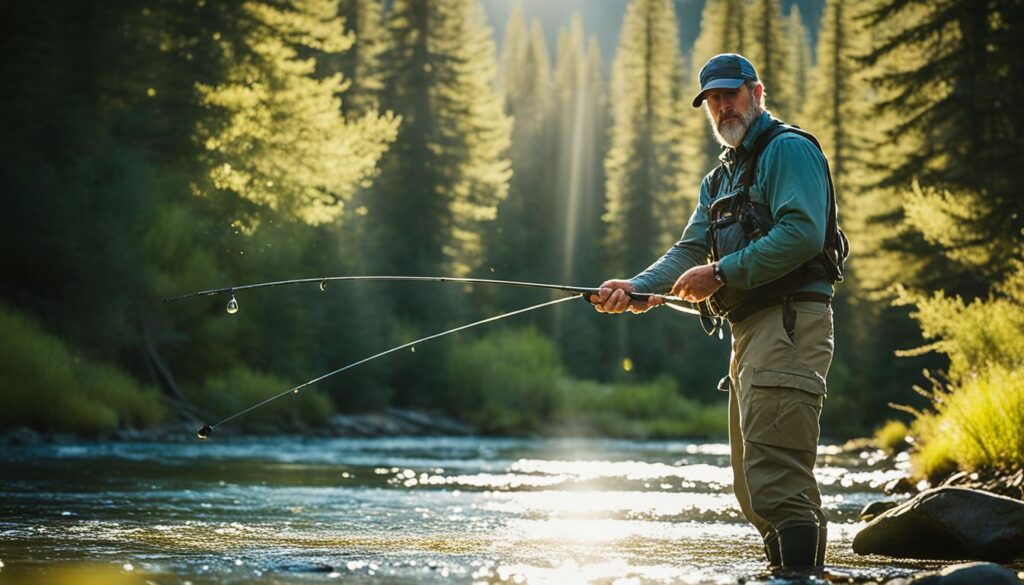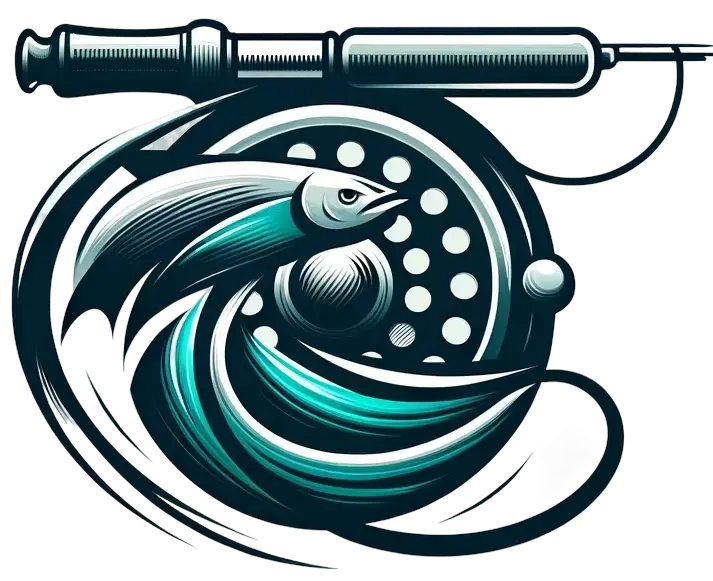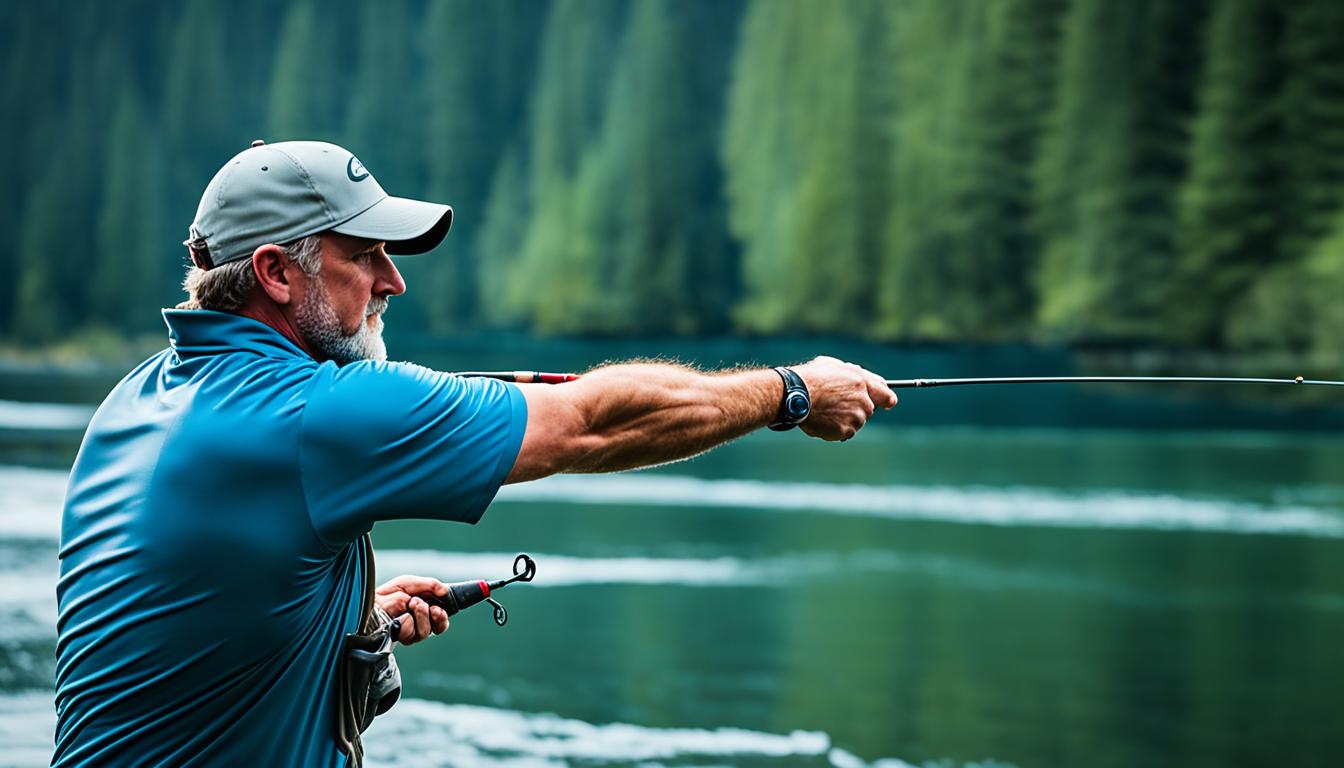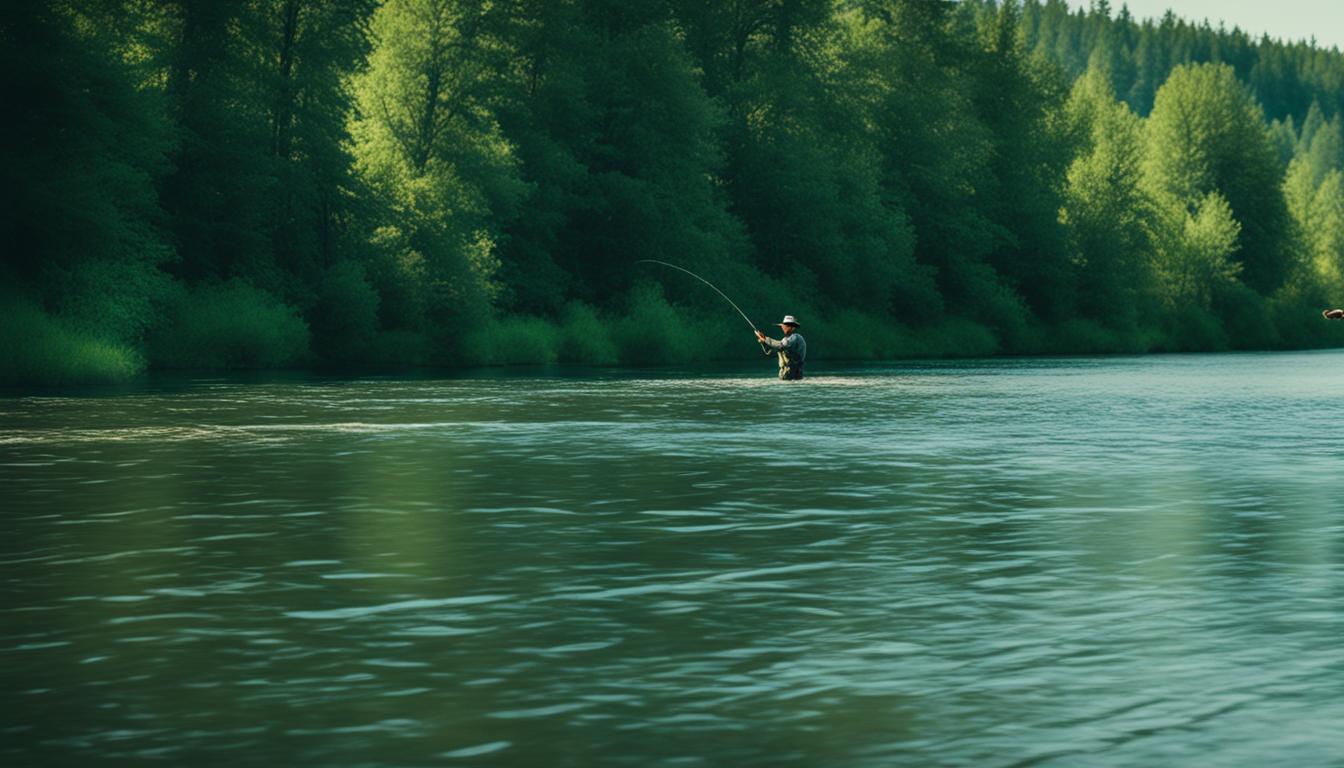Welcome to our guide on swing fishing with wet flies! If you’re looking to improve your fly fishing techniques and catch more fish, mastering the art of swing fishing can take your stream tactics to the next level. Using wet flies in a swing presentation can often outperform other methods like dead drifted nymphs or dries. So, let’s dive in and discover the key elements that make swing fishing with wet flies so effective.
First and foremost, it’s crucial to have a firm hold on the fly line with your rod hand. This ensures that you won’t miss any hook-ups when the fish strikes. Additionally, when using wet flies, it’s recommended to use strong tippets that are slightly larger than what you would use for dry flies. Short leaders also provide more control over the fly’s location and prevent break-offs.
Next, pay close attention to the angle and location of your swing. Slight adjustments can make a big difference in attracting strikes. Don’t forget to read the water and experiment with non-standard casting techniques like in-cast mending to further enhance your success with swing fishing.
Key Takeaways:
- Swing fishing with wet flies is a highly effective technique in fly fishing.
- Hold the fly line firmly with your rod hand to avoid missed hook-ups.
- Use strong tippets and relatively short leaders for more control and prevent break-offs.
- Pay attention to the angle and location of your swing for better results.
- Experiment with non-standard casting techniques like in-cast mending.
The Importance of Fly Presentation in Swing Fishing
When it comes to swing fishing with wet flies, the presentation of the fly is absolutely crucial. A well-executed fly presentation can make all the difference in enticing fish to strike. To achieve a successful presentation, there are a few key factors to consider.
- Leading the Fly: One effective tactic is to lead the fly, pointing the rod slightly downstream of the fly as it swings. This ensures a broadside presentation, allowing the fish to see more of the fly and making it more enticing. By leading the fly, you are presenting it in a way that mimics the behavior of a natural insect, increasing your chances of success.
- Mending the Line: Another important aspect of fly presentation in swing fishing is utilizing mending techniques. By mending the line, you can control the presentation and manipulate the fly’s path. This allows you to maintain the desired angle for a successful swing. Mending is particularly useful in greased line fishing, a technique that focuses on presenting the fly broadside to the fish.
By mastering the art of fly presentation in swing fishing, you can significantly increase your chances of success on the water. It’s all about understanding the behavior of the fish and presenting the fly in a natural and enticing manner. With practice and attention to detail, you’ll be able to consistently deliver a fly presentation that will attract strikes and elevate your swing fishing game.
Remember, each cast and swing is an opportunity to connect with a fish. By honing your fly presentation skills and paying attention to the details, you’ll have a much greater chance of landing that trophy catch. So get out on the water, experiment with different presentation techniques, and enjoy the thrill of swing fishing with wet flies!
Positioning and Casting Techniques for Swing Fishing
When it comes to swing fishing with wet flies, our positioning on the stream plays a crucial role in effectively presenting the fly to the fish. To optimize our chances of success, we need to be strategic about where we stand and how we cast.
First, let’s talk about positioning. When we approach our target area, it’s important to position ourselves upstream and across from the desired spot, facing downstream. This allows us to have better control over the swing of the fly and increases our chances of attracting fish. By standing downstream of the target area, we can cast our lines in a way that allows the fly to swing naturally in front of the fish.
When it comes to casting, we need to be mindful of the angle and direction of our casts. Instead of casting directly across the river or upstream, which can disrupt the natural swing, we should aim for a landing spot that results in a natural swing across the stream. Casting downstream and across is the key to targeting the swing and maximizing our chances of attracting strikes.
To effectively present the fly during swing fishing, we should practice different casting techniques. Cross body and side arm casts are commonly used in wet fly fishing and can help us improve accuracy and control on the water. These casting techniques allow for a more natural presentation and increase our chances of enticing strikes.
Remember, positioning and casting techniques are essential components of successful swing fishing with wet flies. By strategically positioning ourselves and practicing various casting techniques, we can increase our chances of hooking into more fish and mastering the art of swing fishing.

Summary:
- Positioning ourselves upstream and across from the target area, facing downstream, allows for better control over the fly’s swing.
- Avoid casting directly across or upstream, aiming instead for a landing spot that results in a natural swing across the stream.
- Practice cross body and side arm casts to improve accuracy and control during swing fishing.
Mastering the Swing in Wet Fly Fishing
The core aspect of wet fly fishing is the swing. As anglers, our goal is to mimic the behavior of a rising insect by gently swinging the fly across the river. To effectively master the swing technique, there are several important factors to consider:
- Letting the current catch the line and start pulling on the fly. This allows the fly to move naturally and imitate the movement of an insect on the water.
- Guiding the fly across the stream by slowly swinging the rod tip across the current. This helps to maintain control over the fly’s path and keep it in the strike zone.
- Achieving a slow swing. Unlike streamer fishing, where fast retrieves can be effective, wet fly fishing requires a more subtle approach. The slower the swing, the better chance we have of enticing strikes.
- Having proper rod control. By adjusting the height of the rod tip, we can control the depth at which the fly swims. This allows us to imitate rising insects and presents a more realistic target for feeding fish.
- Employing various techniques such as tracking, mending, stripping, and feeding to enhance the presentation. These techniques can imitate the natural behavior of insects and make our flies appear more enticing to fish.
Remember, the specific techniques to use depend on the situation and desired behavior of the fly. By mastering the art of the swing in wet fly fishing, we can greatly increase our chances of success on the water.
Fly Behavior and the Perfect Presentation
Understanding the behavior of flies in the water is crucial for achieving the perfect presentation. The way a fly moves and interacts with the current can determine whether or not a fish will strike. By observing the natural behavior of insects and imitating it with our flies, we can increase our chances of enticing fish to bite.
“The fly should move with the current, exhibiting a subtle and lifelike action that triggers the fish’s predatory instincts.” – Expert Angler
When swinging wet flies, it’s important to pay attention to the speed and depth at which the fly is moving. Adjusting the angle of the rod tip and controlling the line can help us achieve the desired behavior. By tracking the fly’s movement and making subtle mends, we can ensure that the fly looks as natural as possible to the fish.
Strategies for a Successful Swing
To maximize our success with the swing technique, it’s important to consider the following strategies:
- Experiment with different fly patterns to determine which ones are most effective in imitating the insects present in the water.
- Pay attention to the flow of the river and adjust our positioning accordingly. By positioning ourselves in areas where fish are likely to hold, we can increase our chances of getting a strike.
- Vary the speed of our swing to determine what works best on a given day. Sometimes a slower swing may be more effective, while other times a faster swing may trigger more aggressive strikes.
- Stay alert and be ready for a strike at any moment. It’s important to maintain focus and be prepared to set the hook when a fish takes the fly.
By incorporating these strategies into our wet fly fishing approach, we can improve our success rates and have a more enjoyable experience on the water.
| Techniques | Description |
|---|---|
| Tracking | Adjusting the fly’s speed and direction to match the natural movement of insects in the water. |
| Mending | Using small adjustments in the line to control the path of the fly and avoid drag. |
| Stripping | Adding short, intermittent retrieves to imitate the movement of a struggling insect. |
| Feeding | Letting the fly drift freely downstream, imitating a helpless insect being swept away by the current. |
Mastering the swing technique in wet fly fishing takes practice and a deep understanding of fly behavior, rod control, and presentation strategies. By honing these skills and experimenting with various techniques, we can increase our success and elevate our fly fishing game. So, get out on the water, embrace the art of the swing, and enjoy the thrill of wet fly fishing!
Setting the Hook in Wet Fly Fishing
Setting the hook correctly is crucial for successful wet fly fishing. When a trout takes the fly in a wet fly presentation, it’s important to avoid jerking up on the rod, as this can result in break-offs or lost fish. Instead, we recommend using the slip set technique to allow the trout to set the hook itself. To achieve this, release the line under the finger used to hold the line against the handle and raise the rod.
Pointing at the fish with the finger can help ensure the proper set. By releasing and slipping out the line, anglers can allow the fish to strike the fly and improve the hook-up rate while reducing stress on the tackle. This slip set technique is essential for wet fly fishing and can make the process of setting the hook easier and more effective.

Conclusion
Mastering the art of wet fly fishing can significantly enhance your stream tactics and elevate your fly fishing game. By incorporating the wet fly swing technique into your fishing repertoire, you can increase your chances of success on the water and enjoy a thrilling fly fishing experience.
Successful wet fly fishing encompasses various aspects, including proper fly presentation, positioning, casting techniques, and hooking methods. By paying attention to these details and implementing the stream mastery tips discussed in this article, you can improve your wet fly fishing tactics and increase your chances of enticing strikes from fish.
Remember, the key to a successful fly presentation lies in leading the fly, pointing the rod slightly downstream, and using mending techniques to control the fly’s movement. Additionally, positioning yourself downstream and across from the target area, along with utilizing appropriate casting techniques, can enhance the effectiveness of your swing fishing with wet flies.
So, armed with these wet fly fishing tactics and a thorough understanding of successful fly presentation, it’s time to hit the water and put your skills to the test. Practice makes perfect, and with time, patience, and a deep appreciation of the craft, you too can master the art of wet fly fishing and enjoy the thrill of success on the river.
FAQ
What is swing fishing with wet flies?
Swing fishing with wet flies is a fly fishing technique that involves presenting the fly by gently swinging it across the river, imitating the behavior of a rising insect.
Why is fly presentation important in swing fishing?
Fly presentation is crucial in swing fishing as it determines how enticing the fly appears to the fish. Proper presentation techniques like leading the fly and using mending techniques can increase the chances of attracting strikes.
How should I position myself for swing fishing?
When swing fishing, position yourself upstream and across from the target area, facing downstream. This allows you to control the swing of the fly and present it in front of the fish.
What casting techniques should I use for swing fishing?
Casting across and downstream, using cross body and side arm casts, are effective techniques for swing fishing. These casting techniques help present the fly in a natural and controlled manner.
How do I master the swing in wet fly fishing?
To master the swing, let the current catch the line and start pulling on the fly. Guide the fly across the stream by slowly swinging the rod tip across the current. Adjusting the height of the rod tip controls the depth of the fly and imitates rising insects.
What is the best way to set the hook when wet fly fishing?
Instead of jerking up on the rod, anglers should “give with the take” and allow the fish to set the hook itself. By releasing the line and raising the rod, anglers can improve the hook-up rate and reduce the risk of break-offs.
Why is wet fly fishing an effective tactic?
Wet fly fishing is effective because it mimics the behavior of rising insects, enticing fish to strike. By mastering swing fishing with wet flies and employing proper techniques, anglers can improve their chances of success on the water.




